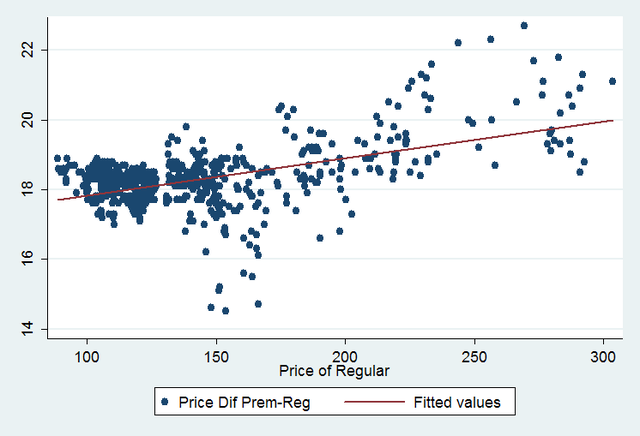A Premium Puzzle
Dave Undis writes to me:
For as long as I can remember, the cost difference between different grades of gasoline has been 10 cents a gallon. For example, when Regular was selling for $2.39, Plus was selling for $2.49 and Premium was selling for $2.59.
Earlier this year when gas prices rose significantly, I noticed this pattern changed. The cost differences were often 8 cents or 9 cents a gallon.
…Can you explain this?
I quickly came up with several explanations for why we might expect an increase in the price differences with a increase in the price of regular but a decrease? That was more puzzling. Being an economist, I question the facts before I question the theory, however, so I graphed the difference in price between premium and regular gasoline against the price of regular gasoline using weekly data from the Energy Information Administration (Nov 28, 1994-July 17, 2006). Click to enlarge.
Dave appears to be incorrect there is a slight tendency for the difference to increase with the price of regular, although the date is noisy. Theory ahead of evidence once again.
Ok, so what’s my explanation?
When the demand for oil rises refineries are pushed to operate at full capacity. Producing premium requires greater effort than regular and this has a higher opportunity cost when refineries are operating at full capacity. (In other words, it’s cheaper to produce premium when you have spare capacity on your hands.) The increase in costs is reflected in the price increase.
There is a countervailing factor, the demand for premium declines (i.e. the relative demand for regular increases) as the price of gas rises. Effects like this can be neat as, for example, when a tax on cigarettes increases the demand for "discount" cigarettes thereby appearing to violate the law of demand. It’s conceivable that the decline in demand (a shift along the supply curve) could counteract the increase in the cost of supply enough to lower the differential but in practice this appears not to occur on average.
Comments are open.